Superfície
de Marte
Deserts are classified by their geographical location and dominant weather
pattern as trade wind, midlatitude, rain shadow, coastal, monsoon, or polar
deserts. Former desert areas presently in nonarid environments are
paleodeserts, and extraterrestrial deserts exist on other planets.
Trade wind deserts
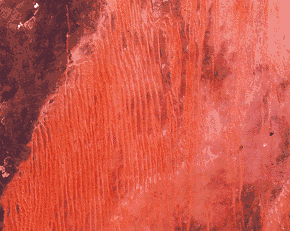
|
The trade winds in two belts on the equatorial sides
of the Horse Latitudes heat up as they move toward the Equator. These
dry winds dissipate cloud cover, allowing more sunlight to heat the land.
Most of the major deserts of the world lie in areas crossed by the trade
winds. The world's largest desert, the Sahara of North Africa, which has
experienced temperatures as high as 57° C, is a trade wind desert. |
| The Sahara of
Africa is the world's largest desert. It contains complex linear dunes
that are separated by almost 6 kilometers. (Skylab photograph).
|
Midlatitude deserts
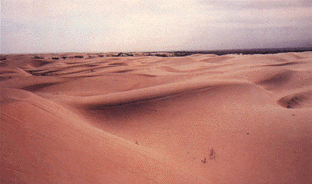
|
Midlatitude deserts occur between 30°
and 50° N. and S., poleward of the subtropical highpressure zones. These
deserts are in interior drainage basins far from oceans and have a wide
range of annual temperatures. The Sonoran Desert of southwestern North
America is a typical midlatitude desert. |
| A rare rain in the
Tengger, a midlatitude desert of China, exposes ripples and a small
blowout on the left. Winds will shortly cover or remove these features.
|
Rain shadow deserts
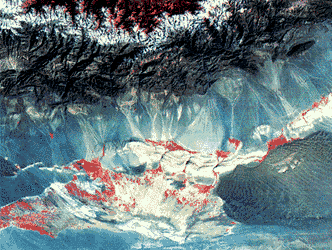
|
Rain shadow deserts are formed because
tall mountain ranges prevent moisture-rich clouds from reaching areas on
the lee, or protected side, of the range. As air rises over the mountain,
water is precipitated and the air loses its moisture content. A desert
is formed in the leeside "shadow" of the range. |
| This Landsat image
shows the Turpan Depression in the rain shadow desert of the Tian Shan
of China. A sand sea is in the lower center on the right, but desert
pavement, gray in color, dominates this desert. The few oases in the
desert and the vegetation in the mountains at the top are in red. A
blanket of snow separates the vegetation in the Tian Shan from the rain
shadow desert. |
Coastal deserts
Coastal deserts generally are found on the western edges of continents
near the Tropics of Cancer and Capricorn. They are affected by cold ocean
currents that parallel the coast. Because local wind systems dominate the
trade winds, these deserts are less stable than other deserts. Winter fogs,
produced by upwelling cold currents, frequently blanket coastal deserts and
block solar radiation. Coastal deserts are relatively complex because they
are at the juncture of terrestrial, oceanic, and atmospheric systems. A
coastal desert, the Atacama of South America, is the Earth's driest desert.
In the Atacama, measurable rainfall--1 millimeter or more of rain--may occur
as infrequently as once every 5-20 years.
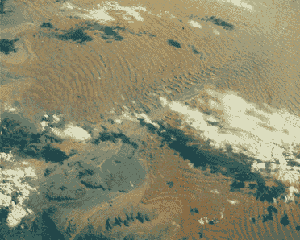 |
| Crescent-shaped
dunes are common in coastal deserts such as the Namib, Africa, with
prevailing onshore winds. Low clouds cover parts of the Namib in this
space shuttle photo. |
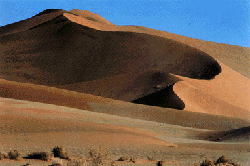 |
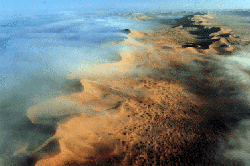
|
| High dunes of the
Namib desert near Sossus Viei (photograph by Georg Gerster).
|
Morning fog
moistens the dunes of the Namib coastal desert (photograph by Georg
Gerster).
|
Monsoon deserts

|
"Monsoon," derived from an Arabic word
for "season," refers to a wind system with pronounced seasonal reversal.
Monsoons develop in response to temperature variations between
continents and oceans. The southeast trade winds of the Indian Ocean,
for example, provide heavy summer rains in India as they move onshore.
As the monsoon crosses India, it loses moisture on the eastern slopes of
the Aravalli Range. The Rajasthan Desert of India and the Thar Desert of
Pakistan are parts of a monsoon desert region west of the ranqe. |
| The Indus River
floodplain, lower left, is the western border of the Thar Desert. This
Landsat image of the monsoon desert shows small patches of sand sheets
in the upper right, with three types of dunes; some dunes are almost 3
kilometers long. |
Polar deserts
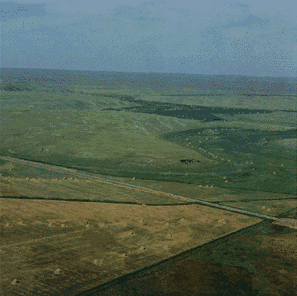
|
Polar deserts are areas with annual
precipitation less than 250 millimeters and a mean temperature during
the warmest month of less than 10° C. Polar deserts on the Earth cover
nearly 5 million square kilometers and are mostly bedrock or gravel
plains. Sand dunes are not prominent features in these deserts, but snow
dunes occur commonly in areas where precipitation is locally more
abundant. Temperature changes in polar deserts frequently cross the
freezing point of water. This "freeze-thaw" alternation forms patterned
textures on the ground, as much as 5 meters in diameter. |
| The Dry Valleys of
Antarctica have been ice-free for thousands of years (courtesy of USGS
Image Processing Facility. Flagstaff. Arizona). |
Paleodeserts
Data on ancient sand seas (vast regions of sand dunes), changing lake
basins, archaeology, and vegetation analyses indicate that climatic
conditions have changed considerably over vast areas of the Earth in the
recent geologic past. During the last 12,500 years, for example, parts of
the deserts were more arid than they are today. About 10 percent of the land
between 30 N. and 30 S. is covered now by sand seas. Nearly 18,000 years
ago, sand seas in two vast belts occupied almost 50 percent of this land
area. As is the case today, tropical rain forests and savannahs were between
the two belts.
Fossil desert sediments that are as much as 500 million years old have
been found in many parts of the world. Sand dune-like patterns have been
recognized in presently nonarid environments. Many such relict dunes now
receive from 80 to 150 millimeters of rain each year. Some ancient dunes are
in areas now occupied by tropical rain forests.
The Nebraska Sand Hills is an inactive 57,000square kilometer dune field
in central Nebraska. The largest sand sea in the Western Hemisphere, it is
now stabilized by vegetation and receives about 500 millimeters of rain each
year. Dunes in the Sand Hills are up to 120 meters high.

|
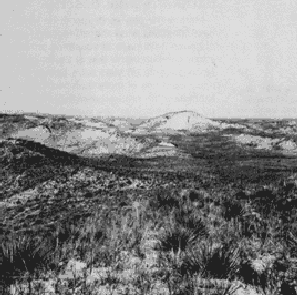
|
| This aerial
photograph of the Nebraska Sand Hills paleodesert shows a well-preserved
crescent-shaped dune (or barchan) about 60 to 75 meters high. (Photograph
by Thomas S. Ahlbrandt) |
A dry community of
vegetation grows among the dunes of the Nebraska Sand Hills. (Photograph
by N.H. Darton) |
Extraterrestrial deserts
Mars is the only other planet on which we have identified wind-shaped (eolian)
features. Although its surface atmospheric pressure is only about
one-hundredth that of Earth, global circulation patterns on Mars have formed
a circumpolar sand sea of more than five million square kilometers, an area
greater than the Empty Quarter of Saudi Arabia, the largest sand sea on our
planet. Martian sand seas consist predominantly of crescent-shaped dunes on
plains near the perennial ice cap of the north polar area. Smaller dune
fields occupy the floors of many large craters in the polar regions.

|
| This Viking
spacecraft image of Mars shows alternating layers of ice and windblown
dust near the north polar cap. Annual and other periodic climatic
changes due to orbit fluctuations may occur on Mars (courtesy of USGS
Image Processing Facility, Flagstaff, Arizona). |

|
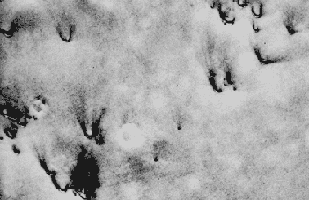
|
| One of the first
images taken at the Viking 2 landing site on Mars shows the pink sky
over Utopia and the desert pavement on the ground (courtesy of NASA).
|
Some of the
crescent-shaped dunes in this Viking image of Mars are more than a
kilometer wide. The dark material that streaks from the horn-shaped
features may be dust recently blown from the dunes (courtesy of NASA). |
Conheça
o Ache Tudo e Região
o portal de todos Brasileiros. Coloque este site em
seus favoritos.
Cultive o hábito de ler, temos diversidade de
informações úteis ao seu dispor.
Seja bem vindo, gostamos de suas críticas
e sugestões, elas nos ajudam a melhorar a cada dia.













